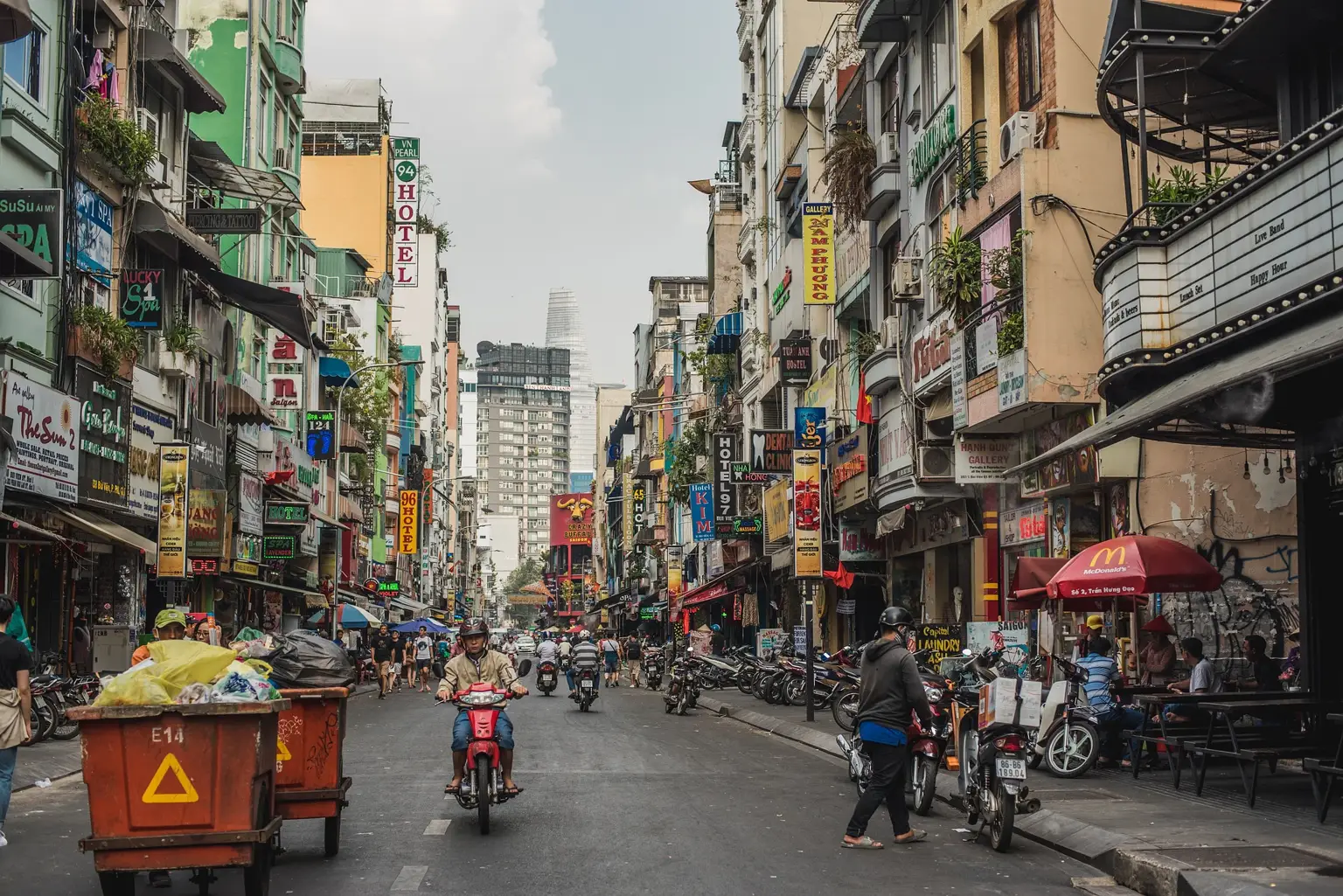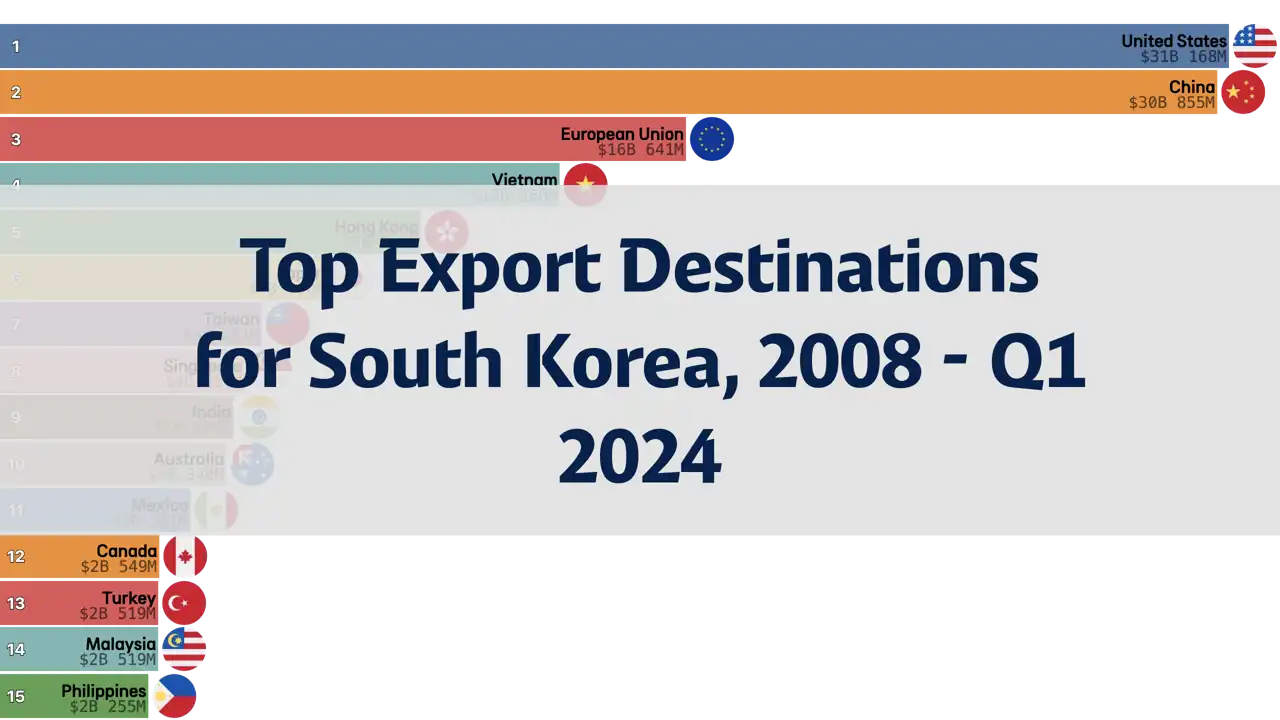
Korea’s Top 10 Export Markets in Q1 2024: Breaking Down the Numbers and Trends
- ASUMUP
- Economy
- September 9, 2024
As the global economy continues to evolve, South Korea remains a key player in international trade. In the first quarter of 2024, Korea showcased strong performance in exports, reaching several of its major trading partners. The country's export figures reflect its strategic position as a hub for technology, automobiles, and industrial goods. This post delves into the top 10 countries and regions that received the highest volume of South Korean exports during the first three months of the year.
From high-tech goods to heavy industry, South Korea's export economy is highly diversified, and its major trading partners range from traditional markets like the United States and China to newer, rapidly growing economies such as Vietnam. The figures for Q1 2024 provide valuable insights into Korea’s shifting export landscape and global trade partnerships.
In this article, we explore Korea’s top 10 export destinations by breaking down the numbers and looking at the broader trends behind these figures. Each of these destinations represents a significant economic relationship with South Korea, whether through mutual industrial growth, consumer demand, or technological exchange.
Korea's Top Export Destinations in Q1 2024
- 1st United States of America – $31.2 billion
- 2nd China – $30.9 billion
- 3rd European Union – $16.6 billion
- 4th Vietnam – $13.3 billion
- 5th Hong Kong – $9.5 billion
- 6th Japan – $7.0 billion
- 7th Taiwan – $5.3 billion
- 8th Singapore – $4.8 billion
- 9th India – $4.5 billion
- 10th Australia – $4.3 billion
10th Australia – $4.3 billion
Australia rounds out South Korea’s top 10 export destinations, with goods valued at $4.3 billion in Q1 2024. The economic relationship between the two countries is characterized by trade in industrial goods, including automobiles and machinery. Australia’s demand for South Korean cars, particularly electric vehicles, has been growing, along with imports of electronics and chemical products.
Both countries benefit from a robust trade agreement that facilitates smoother transactions, and South Korea continues to be a major supplier of advanced technology to Australia.
9th India – $4.5 billion
South Korea exported $4.5 billion worth of goods to India in the first quarter of 2024. As India continues to industrialize and expand its manufacturing base, the demand for South Korean machinery, electronics, and chemical products has risen.
India is one of South Korea’s most important trade partners in South Asia, with their economic relationship expected to grow even further in the coming years. The two countries are investing in various sectors, including automotive and energy, creating more opportunities for South Korean exports to thrive in India.
8th Singapore – $4.8 billion
Singapore, as a global financial and trading hub, imported $4.8 billion worth of South Korean goods in Q1 2024. The city-state is a major destination for South Korean technology products, including electronics and IT equipment, which support Singapore's role as a leading tech and finance hub in Southeast Asia.
South Korean companies benefit from Singapore’s strategic location and its position as a logistics and distribution hub for the broader Southeast Asian region. This makes Singapore an important market for South Korean exports, particularly in high-tech sectors.
7th Taiwan – $5.3 billion
Taiwan imported $5.3 billion in South Korean goods during the first quarter of 2024, with semiconductors and related technologies leading the way. Both South Korea and Taiwan are powerhouses in the global semiconductor market, and this shared industry plays a crucial role in their trade relationship.
In addition to technology, other sectors such as chemicals and machinery also contribute to the growing trade between the two countries. Taiwan's strong demand for high-quality components ensures a robust market for South Korean exports.
6th Japan – $7.0 billion
South Korea exported $7.0 billion worth of goods to Japan in the first quarter of 2024, a testament to the close yet competitive economic relationship between the two countries. Both nations are leaders in technology and industrial manufacturing, and they share deep economic ties, despite occasional political tensions.
Key export sectors include machinery, chemicals, and electronics. South Korean tech products, particularly semiconductors and consumer electronics, are vital to Japan's industries, ensuring continued trade between these neighboring countries.
5th Hong Kong – $9.5 billion
Hong Kong, as a Special Administrative Region of China, remains a vital trade partner for South Korea, with exports reaching $9.5 billion in Q1 2024. Hong Kong serves as a major re-export hub, where goods are imported and then shipped to mainland China and other Asian markets. The city's strategic position and developed logistics infrastructure make it an important gateway for South Korean products, especially in the fields of technology and consumer goods.
Electronics and high-end technology continue to dominate the export categories to Hong Kong, and the city remains a valuable partner in the distribution and re-export of South Korean goods to other parts of the region.
4th Vietnam – $13.3 billion
Vietnam continues to grow as a significant export destination for South Korea, with Q1 2024 exports totaling $13.3 billion. Vietnam’s increasing role as a manufacturing hub in Southeast Asia has contributed to the rise in South Korean exports, particularly in electronics, industrial machinery, and raw materials. Many South Korean companies have manufacturing plants in Vietnam, which helps streamline the supply chain for goods produced in both nations.
The economic relationship between South Korea and Vietnam is mutually beneficial, with South Korean firms heavily investing in Vietnam's industrial sectors. This synergy is reflected in the rising export numbers, as Vietnam's economy expands rapidly and demands more goods from South Korea.
3rd European Union – $16.6 billion
The European Union is South Korea's third-largest export market, receiving $16.6 billion in goods during the first quarter of 2024. The EU’s demand for South Korean automobiles, machinery, and electronics remains strong, and the two regions maintain a healthy trade partnership. This relationship is further reinforced by the EU-South Korea Free Trade Agreement, which has facilitated smoother and tariff-free trade.
South Korea’s automotive sector, particularly with brands like Hyundai and Kia, has found significant success in Europe, where eco-friendly and high-tech vehicles are in demand. Additionally, South Korean electronics and industrial machinery are vital to the EU's diverse industries.
2nd China – $30.9 billion
Despite geopolitical tensions and a slight cooling in trade, China remains a vital export market for South Korea, receiving $30.9 billion worth of goods in Q1 2024. South Korea exports a wide range of products to China, including semiconductors, chemical products, and electronics, which are essential for China's manufacturing and technological sectors.
Although China’s economic growth has slowed compared to previous years, its massive demand for components and raw materials needed in its own production processes ensures that South Korea continues to benefit from the trade relationship. The export figures indicate that China is still an essential player in South Korea’s overall export strategy.
1st United States of America – $31.2 billion
In Q1 2024, the United States was the largest recipient of South Korean exports, with goods valued at approximately $31.2 billion. The strong trade ties between the two nations are driven by several key industries, including semiconductors, automobiles, and electronics. The US remains a critical market for South Korea, especially with the continued demand for advanced technology products and automotive components.
South Korean companies like Samsung, Hyundai, and LG have a significant presence in the US, further solidifying the strong economic relationship between the two nations. The high volume of exports to the United States reflects both countries' commitment to sustaining their trade partnership, which continues to be a cornerstone of South Korea's economic growth.
Other Posts in the Economy
Categories
- National Rankings(43)
- Science & Technology(1)
- Sports(24)
- Economy(30)
- Society(12)
- Culture(7)
Recent Posts
![Bayern Spent HOW MUCH on Harry Kane?! Ranking Their Top 10 Biggest Signings Ever]() A deep dive into Bayern Munich's ten most expensive transfers, exploring how the club's spending strategy has evolved to chase European glory.
A deep dive into Bayern Munich's ten most expensive transfers, exploring how the club's spending strategy has evolved to chase European glory.![Arsenal's Record-Shattering Spree: From a €116M Gamble to a Flop, Who Was Worth the Cash?]() A deep dive into Arsenal's top 10 most expensive signings, analyzing the successes, the failures, and the massive fees that have defined the club's modern transfer strategy.
A deep dive into Arsenal's top 10 most expensive signings, analyzing the successes, the failures, and the massive fees that have defined the club's modern transfer strategy.![Chelsea Cashes In BIG TIME! Who Really Won the 25/26 Summer Transfer Window Money Game?]() A deep dive into the top 10 clubs that made the most money from player sales during the wild 25/26 summer transfer window.
A deep dive into the top 10 clubs that made the most money from player sales during the wild 25/26 summer transfer window.![Liverpool's Record-Breaking €483M Spree! Did They Just Buy the Premier League Title?]() A deep dive into the 25/26 summer transfer window reveals Liverpool's record-breaking spending spree as Premier League clubs continue to dominate the market.
A deep dive into the 25/26 summer transfer window reveals Liverpool's record-breaking spending spree as Premier League clubs continue to dominate the market.![You Won't Believe How Much a Loaf of Bread Costs in These Countries! (Spoiler: It's INSANE)]() This post explores the top 10 countries with the most expensive bread, revealing how factors like import reliance and tourism dramatically inflate the cost of this basic staple.
This post explores the top 10 countries with the most expensive bread, revealing how factors like import reliance and tourism dramatically inflate the cost of this basic staple.
















